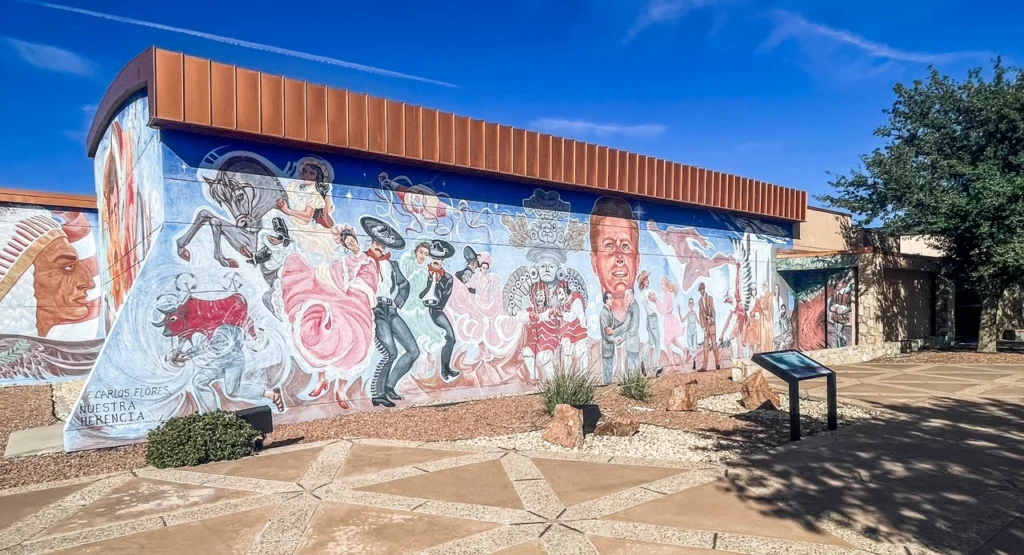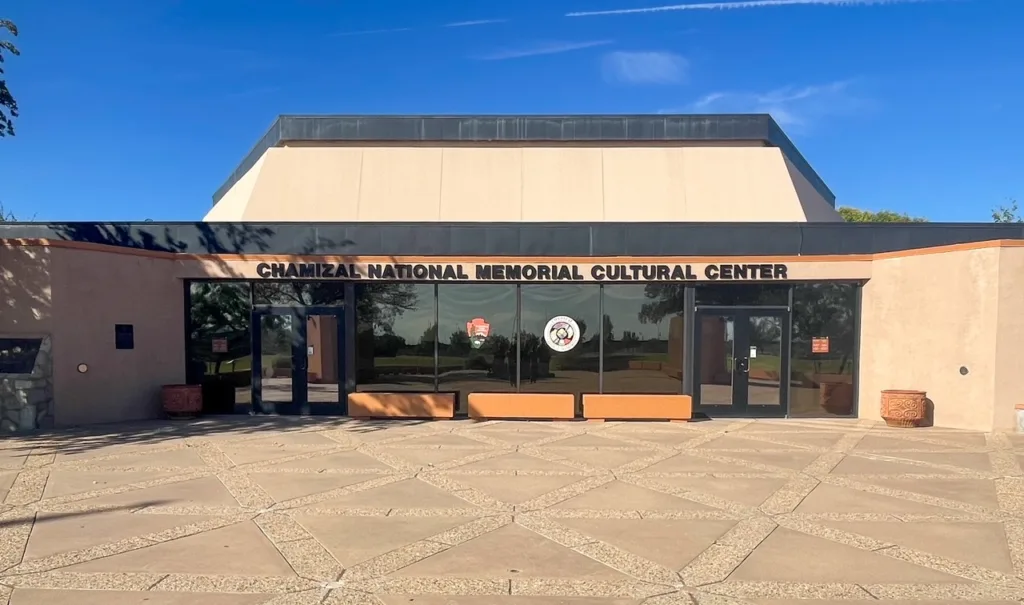What is a Border. That is something that Chamizal National Memorial discusses in one of the most important agreements many of us never heard of.
The National Memorial examines one of the most contentious and yet peaceful agreements that moved two neighbors forward. Something that’s a discourse that is lose in many ways present day.
Explore the park and the history.

About the National Memorial
1848
The Treaty of Guadalupe Hidalgo officially ended the bloody conflict between the United States and Mexico.
US Troops occupied Mexico City and Mexico was forced to cede over 50% of its national territory. These include areas of present day California, Arizona, New Mexico, Nevada, Utah, Colorado, Oklahoma, Kansas, and even Wyoming.
The border between the countries for much of the border is determined to be the Rio Grande.
But…what do you do if a river moves?
The River
The Rio Grande for much of its history was a free flowing river. This meant that the river changes course at times. And such was the case in 1864, when flooding caused the river to move further South into what was then Mexican National Territory.
There was no exact definition of the boundary other than the river. The boundary of the country would change course with the river, as it was gradually meant to do. Sudden changes were not supposed to change the border so drastically.
However, following the moving of the river, residents of El Paso began moving into the area known as El Chamizal. Should they have been allowed to? That is definitely up for debate as their was a lot of question as to the legality of such a move.
US and Mexico tried to better agree on the formal boundaries and set a commission to keep track of those. However the Border Commission could not come to an agreement on El Chamizal.

Cordova Island
However, this was not the last movement for the river. In the 1890s, the River moved drastically again and this time with some support of trying to mitigate the flood, it caused an area of Mexico north of the Rio Grande. As the former riverbed still remained the border between the countries.
This continued to complicate things between the two countries.
Arbitration
It seemed that Arbitration with the International Border Commission did not quite resolve the dispute between the two countries. The US did not agree to the end result and the land that was expected to be traded.
This continued for decades, and the border continued to be a unresolved conflict. And yet, people still continued to settle in the disputed areas, lives continued to grow.
Resolution
However, slowly things started to move in the right direction. There was work on better managing the course of the Rio Grande and not having as much movement of the direction over the years. This required some exchanging of land but not El Chamizal.
It wasn’t until the 1960s under Presidents John F Kennedy and Adolfo López Mateos that real movement went forward. They were able to hash out an agreement, something that has eluded both governments for years.
No government got everything they wanted, but each had to give up something and each got something. Parts of El Chamizal and Cordova Island went to each country.
And both actually set up small areas of land for memorials (such as this one) in remembrance of the conflict.
Aftermath
Not everyone obviously was happy. People had settled, built homes and started lives in the area of El Chamizal and have lived there for decades. Many older people did not want to move from the homes they’ve known for years.
This required the governments to buy land from the various folks and help them with resettlement. Not something that was easy.
Obviously, people on both sides also hated the idea of giving up any territory to the other country. However, shockingly for such a complicated situation, it resolved itself pretty peacefully.
I do wonder if such an action would be possible present day.

Visiting the National Memorial
The memorial is worth a visit to explore and understand this history. I knew nothing about it myself. Probably because I’m too young to have been around for any of this conflict.
The park area is actually quite beautiful although its so strange seeing the border so close behind barbed wire to the south. I noticed so many border control law enforcement people near to the memorial.
One of the things I really enjoyed seeing is the border markers that are on the north side of the park. Be sure to these out near the parking area, before leaving. It’s really worth seeing how much the border has changed over the years.
The mural is a bit odd, but it’s quite lovely. The exhibits are great. I think they do a wonderful job explaining the site and the history.
Overall though, there isn’t too much to do both here and in the area. I recommend combining it with something else if you can.
Things To Do
Explore a few of the great things to do in the park. There’s also opportunity to just hang out on the greens, picnic, and enjoy nice weather.

Exhibits and Movie
The main visitor center has both information as well as great exhibits and a movie about the El Chamizal conflict. I think this is the most important first place for visitors as it actually explains what the conflict is and the how it was resolved.
Overall, they did a great job with various news articles, people’s stories, and information on the conflict. I think it is a wealth of information and quite a well made exhibit.

Boundary Markers
North of the parking area and the visitor center you can visit the original boundary markers between the countries.
This is really strange to be able to see the old stone pillars that designated the boundary. As well as realize that yea, so this part of the land was not all the US until it was “officially” changed.
I found the border markers to be one of my favorite things to see.

Mural
The artist, Carlos Flores from Mexico painted this impressive mural in 1992. The mural expresses a rich series of history and culture of the area and of the United States and Mexico. The 18 x 120 foot mural is a beautiful blend of so many scenes. The mural was updated in 2016, which is why you can see Barack Obama among the images on the panel (he also visited the memorial).

Basic Information
Visitor Center
Address: 800 S San Marcial St, El Paso, TX 79905
Hours: 10:00 am – 5:00 pm
There is a visitor center for the park located in the main building on the site. The center has information about the park, the passport stamp, exhibits on Chamizal and the agreement, a movie, and bookstore.
Fees
Entrance and Parking at the Site is Free.
Hours
The Park is open daily from 7:00 am – 10:00 pm daily. Closed on some holidays.
Be sure to be out of the park or at least not leave your car in the park after 10pm or it will be towed.
National Park Passport Stamp
There is a national park passport stamp for Chamizal in the visitor center. There’s only one visitor center and main building for the site.
Website: Official NPS Site

Where to Stay Near Chamizal National Memorial
There is no shortage of hotel options in El Paso. Some of the ones I recommend are below.
- Courtyard Marriott Downtown: I like the hotel and its downtown location near the El Paso History Museum. Downside is there’s a parking fee.
- Hyatt Place El Paso Airport: Good Option and Good Prices. Reasonable Distance as nothing is too far in El Paso
- Embassy Suites El Paso: Great Hilton Option located close to the Bassett Place Mall.
- Comfort Suites El Paso Airport: Reasonable Prices, Close to the airport. Not my favorite location, but the price is right.
Getting There
GPS Location: 31.767678, -106.454135
Chamizal National Memorial is located in the Chamizal neighborhood of El Paso. The site is actually really close to the International Border (you can see it from the memorial) and I noticed there was a lot of police in the area as well.
The entrance to the memorial is located on Delta Drive.
By Air
The closet airport to Chamizal National Memorial is the El Paso (ELP) International Airport. Staying near the airport is actually a pretty good option for those visiting.
Other Posts you May Like
- TEXAS: Guide to Guadalupe Mountains National Park
- TEXAS: Best Day Trips from El Paso
- TEXAS: Guide to Seeing the Famous Austin Bats
- NEW MEXICO: Guide to White Sands National Park
Leave a Reply